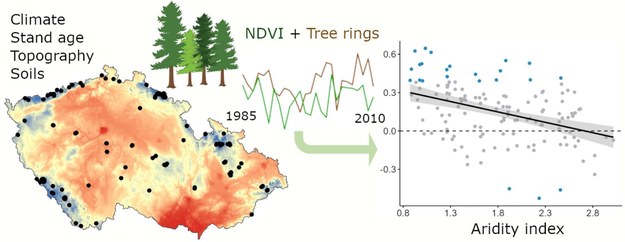New Insights into Climate Response of Forest Ecosystems
The study, titled "Shifting climatic responses of tree rings and NDVI along environmental gradients," examines the coherence of climatic responses of tree rings and NDVI, a crucial aspect in understanding the dynamics of forest ecosystems. "Our research delves into how tree growth and foliage vitality respond differently to climate variations across a range of environmental conditions," explains corresponding author of the study Dr. Jiří Mašek from the Department of Physical Geography and Geoecology, Faculty of Science, Charles University. This decoupling of TRI and NDVI responses is particularly evident across various environmental gradients.
Key findings from the study include:
-
Relationship Explained by Climate, Topography, and Soil: The study found that the relationship between TRI and NDVI is influenced by factors like climate, topography, and soil category.
-
Agreement in Warm/Dry Conditions: The research revealed a consistency between TRI and NDVI in the warmer and drier parts of the Picea species range.
-
Different Sensitivities to Climate and Stand Age: TRI was found to be more sensitive to climate and stand age, whereas NDVI reflects a combination of climate, topography, and soil conditions.
The study involved analyzing the growth of Picea abies at 138 sites across Czechia. By employing tree-ring chronologies and Landsat imagery-derived NDVI time series, the team correlated these factors with summer temperature and standardized precipitation evapotranspiration index (SPEI). The research highlighted how climatic responses varied with aridity index, soil category, stand age, and topographical factors.
"Our findings are crucial in understanding how forest ecosystems might react to ongoing climate change. It's clear that canopy vigor and stem growth may exhibit different trends under changing climatic conditions" states Dr. Mašek.
The research underscores the importance of variations in the growth of aboveground biomass compartments, like tree stems and foliage, in influencing the carbon cycle of forest ecosystems. The unique insights gained from this research are expected to contribute to the field of forest ecology and environmental science.
Reference a link to the original study:
Mašek, J., Tumajer, J., Lange, J., Vejpustková, M., Kašpar, J., Šamonil, P., Chuman, T., Kolář, T., Rybníček, M., Jeníček, M., Vašíčková, I., Čada, V., Kaczka, R., Rydval, M., Svoboda, M., Nedělčev, O., Hais, M., & Treml, V. (2024). Shifting climatic responses of tree rings and NDVI along environmental gradients. Science of The Total Environment, 908, 168275. https://doi.org/10.1016/j.scitotenv.2023.168275

Document Actions